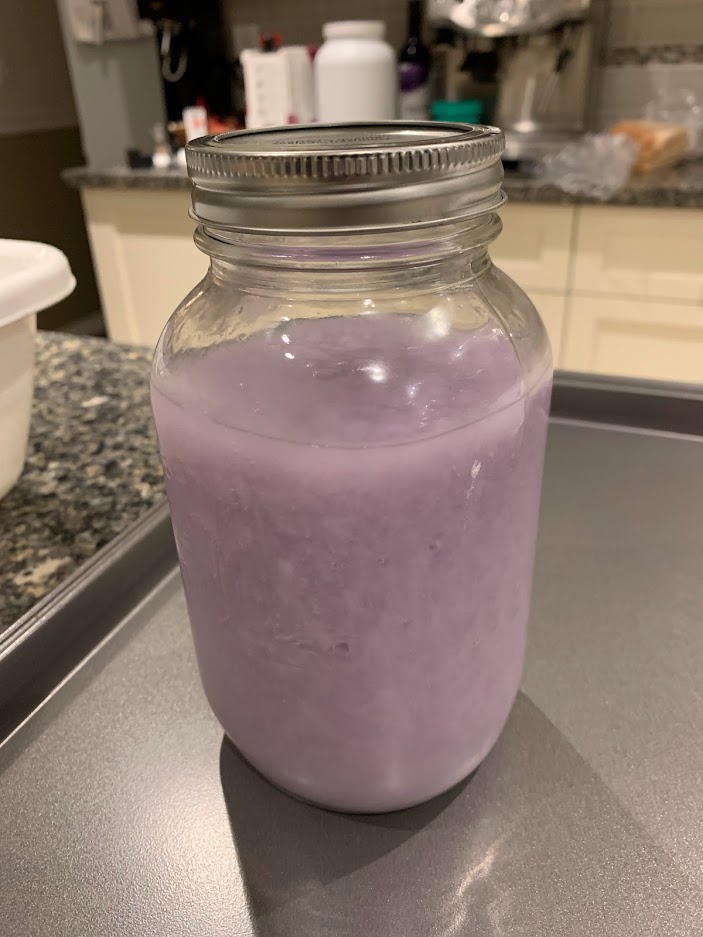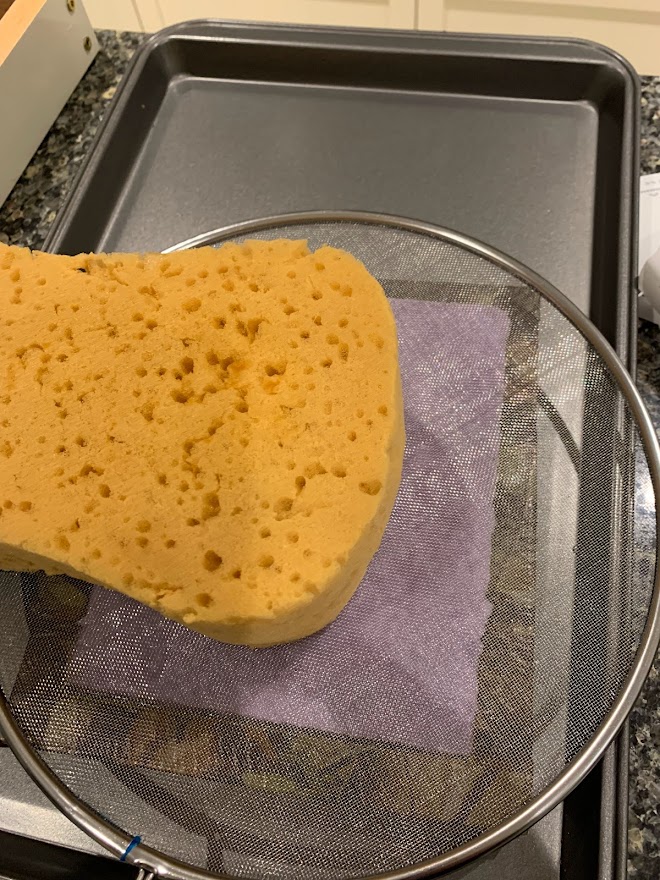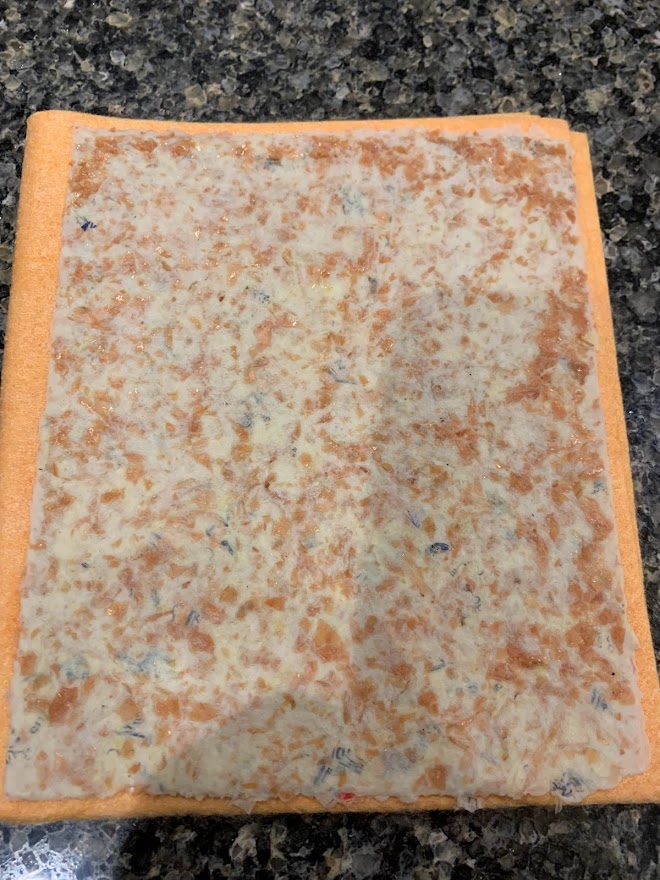So, previous readers may recall my latest obession – paper making. It’s also well covered in my recent reading history which has been cost-effectively aided by our wonderful local library and its extended reach through the inter-library loan system. Most of the books cover the same ground, with little new to add. Some lean heavily on the history and various methods traditionally used around the world. Others have examples of art using the handmade paper – a lot of which looks like nothing so much as kindergarten projects… but a lot more expensive because of who made them.
One or two books I found helpful though because they emphasised the fact that it’s an experimental “craft”. A bit like baking… follow the recipe to the letter and you’ll get something approximately like the picture. But not exactly. It’ll have a certain je ne sait quoi that you yourself added to the mix. And that’s refreshing. The fact that you’re not trying to exactly replicate the photo, but use it as a spring board to make your own unique paper. Once you accept that, you’re free to mix things up a little and try your own extensions from the basic suggestion.
One book I really enjoyed (to the point I ordered a used copy from Abe Books) is Handmade Paper from Naturals by Diane Flowers (with no hint of irony!) Ms Flowers makes the obvious connection between handmade paper and the traditional European source of paper pulp… old cotton rags. She credits one Patty Cox with the original recipe, but essentially she suggests the genius move of beefing up the usual pulp made from old recycled paper (receipts, envelopes (minus the gum and plastic window), letters from the landlord, etc.) with pieces of denim. The cotton fibres in the denim add huge amounts of strength and body to the feeblest of recycled paper (much of which may itself have already been recycled, weakening its fibres).
So here’s my own learnings and experimental results…
I began with an old pair of jeans. I’d been steadily cutting lengths off the legs for use in bookbinding projects. Given I was going to be pulping the fabric for this, I began with the least useful parts for anything else. It was pretty therapeutic to use a stitch-ripper to undo the waistband and undo all the fold-over hems. I aimed for about an A4/letter sheet of paper’s worth of area, though obviously it wasn’t in sheet form. Naturally, I removed rivets and any card or leather stiffeners (yes – I seam-ripped the belt loops to use the fabric from them too… waste not, want not!)
Next, I used some sharp tailor’s scissors to cut up the denim into roughly 1cm squares. I didn’t want to damage the blender, and didn’t want any long threads that might wrap around the blades and cause the motor to stall. I put the small pieces in a bowl and covered them with water to soak over night. I’m not sure how necessary this is, but I figured it might soften up the threads and make shredding easier.

As per the book recipe, I then prepared about 5 sheets worth of recycled paper and added that to the water to soak with the denim. The general consensus is to tear recycled paper into ~2″ squares prior to blending so as not to unduly shorten the fibres in the paper prior to the blending operation. However, I’ve more recently taken to using a home office shredder to prepare the “stock” paper, and given the punishment the blades of a typical home blender mete out to the pulp, I don’t think this step is as key as one might think… at least for recycled paper. I can see it being much more important for prepared “virgin” pulp such as cotton linter or abaca.
I hadn’t done this pre-soaking previously, and I must say, it works well to release any dyes or other ink in the recycled paper. You can drain it off before adding the wet paper/denim to fresh water in the blender. I typically add 1 litre (a Mason jar’s worth) of water to the blender first, and then add about a fistfull of paper (and in this case – denim). I begin on slow speed then ramp up to full-on ludicrous speed for as long as it takes to make smooth pulp. Again – personal preference for smooth vs. chunky and a note that very smooth equals shorter fibres (and weaker paper generally +/- sizing).
What I got was a little unexpected. The resulting pulp was smooth enough… but a little clumpy. Odd. No un-blended paper or “unprocessed lumps” as such (the very occasional small piece of denim is actually quite attractive if one or two survive the blending operation, but there shouldn’t be many.) But there were definite clumps to the pulp. Almost stringy, like the unspeakable horrors that can clog up a shower drain if one or more members of your family have long hair and enjoy the over-use of hair products.
This is actually the result of the cotton fibres in the now thoroughly macerated and masticated fabric. The fibres are no longer even threads – none of which was more than 1cm long anyway. Now they are individual fibres which slip and slide together within the paper pulp to make longer gloopy threads… which of course is how cotton thread is made in the first place by spinning. This is why it is necessary to be careful to listen to the blender motor and stop it immediately if you hear it straining – the gloopy thread-like pulp can wind around the blades and choke the motor, causing it to over-heat and potentially become damaged. Then you’ll be in trouble with the head chef!
I continued this procedure – one litre at a time – until I’d processed all the paper/denim – I think it came to about 7 Mason jars of pulp in the end. Time had marched on though, so I put them in the fridge until I had time to make paper with them.
The pulp had gorgeous swirls of indigo blue with white, so I had no expectation of being able to write on the resulting paper. This was “experiment one” so I didn’t bother adding any sizing at all, though if I were to make it again (I did make a second batch, but more on that later) I’d add sizing and press it smooth so it’s less fabric like when complete.
I got my 30 litre vat ready on a tressle table in the garage (I’ve been formally banned from the kitchen now… “things go missing”, I’ve been told), and added the Mason jars of pulp. The batch-to-batch variation in colour was quite remarkable due to the random ratio of indigo-laden denim to recycled off-white paper in each jar. If I were to add sizing, this would be when I’d do it, before I add the water. At this point, the water present is just that used to make the pulp with, and the sizing would be left to soak into the fibres before adding more water to the vat.
I finally tracked down some good old-fashioned wallpaper paste (essentially cellulose starch) which should keep me in sizing for years to come (a spoonful per vat should do it), once I eventually burn through my “proper” sizing bought from a papermaking supplier. I’m not sure if wallpaper is no longer de rigeur in Canada, but it was really hard to find, and I’m pretty sure it’s old stock as it is!
Anyway, a gentle swirling of the non-sized pulp mixed the colour more evenly, and the gloopiness was still very much apparent. Next, I added a 5 gallon bucket of hot tap water, and continue to swirl the contents to disperse the pulp evenly. The temperature is not important for the paper making, but since you’re dipping your hands in it for a while, I just find it more comfortable.
Then, I pulled the paper just like with any other pulp… but found it decidely harder to get it to lay evenly on the mould. The clumpiness tends to stop the pulp distributing as evenly as the pulp normally does. I’d say the pulp was too concentrated/thick in the vat, but the situation persisted even as the pulp content dwindled towards the end of the evening. (If this were more of a “production” run rather than experimentation, I’d hold back a couple of litres of pulp to top up the vat after every few sheets, to help keep the “strength” of pulp relatively stable.) Towards the end, I drain off a few litres of water by seiving the vat’s contents and discarding the water onto the garden. That lets me pull one or two more sheets with a shallower vat by increasing the pulp strength.
At the very end, I use the last dregs by pouring over a smaller deckle/mould rather than dipping. Alternatively I could seive it and let it dry as a puck – blending it with the next pulp batch on another day.

I pressed and dried the paper as usual and found it became a lot paler as it dried. It looks fantastic though, and almost looks like fabric rather than paper.

It is certainly more fibrous than paper made from standard recycled pulp, and a little harder to cut. It makes phenomenal looking envelopes though.
I mentioned a second run. This time I doubled the amount of recycled paper added to the denim, hoping for a less soft/fabric-like result. It’s still drying, so no photos I’m afraid, but visually it looks the same with those amazing swirls of blue and white mixed into the base paper.
I hope you found this of some use or interest. Let me know if you’ve tried something similar and what you learnt.














































